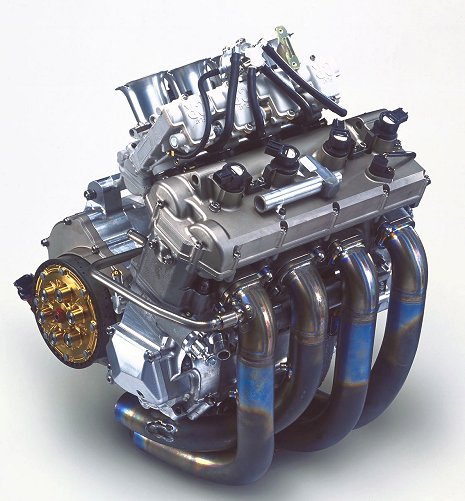
Yamaha has published the following information regarding the ongoing development of the YZR-M1 MotoGP machine, now featuring a carbureted engine (pictured). The irony here is the simultaneous release of the fuel-injected R1 street bike, featuring outstanding fuel injection (see our first ride report).
The YZR-M1, Yamaha’s 4-stroke racer for the 2002 MotoGP season that has been in development for over a year, is in the final stages of testing and on schedule for its big debut. In February and March the machine will be put through final tests on the various race circuits of Europe with the aim of honing its performance over the actual MotoGP race distance. Then it will make its long-awaited race debut at the opening round of the 2002 season at Japan’s Suzuka Circuit on April 7th in the hands of Marlboro Yamaha Team riders Max Biaggi and Carlos Checa.
The new YZR-M1 is powered by an all-new under 990cc liquid-cooled 4-stroke DOHC, 5-valve, in-line four-cylinder engine that has been developed by Yamaha engineers for the ultimate in lightweight, compactness and high performance. The engine is roughly 10% lighter than the 749cc engine that powers the current Superbike spec YZF-R7. Adopting a carburetor type intake system, the engine pumps out over 200 PS.
The M1 utilizes a new aluminum Deltabox frame that has been developed from the successful 2-stroke YZR500, long acknowledged as one of the best-handling machines in Grand Prix racing. The new frame has been redesigned to accommodate the unique characteristics of the new 4-stroke engine. It features new dimensions and parts as well as optimized positions of their relative layout. The new design achieves the balance of rigidity that is essential to an outstanding GP racer. Also, structural elements like an adjustable head pipe and adjustable pivot axis make for fast and exacting setting adjustments to fit the many different characteristics of each race track. Here is what YZR-M1 Project Leader, Mr. Ichiro Yoda, has to say about the progress of the tests and the machine itself.
“Beginning in 1973, Yamaha engineers have worked continuously on developing 2-stroke race machines for the GP500 class and this considerable experience has taught us that the best measure of the overall performance of a race machine is expressed in the concept of ‘drivability’. Naturally this was also the concept we stressed in the development of the YZR-M1.”
“In other words, we placed top priority on developing more usable power development character in the engine. If we were only focusing on max power output, we could have raised the output. But that would not necessarily mean better lap times or competitiveness on the racetrack. We sought to develop engine and chassis characteristics that would communicate the drive force of the rear tire to the rider more directly, create better contact between the rear tire and the track surface and produce more efficient tire performance. It was these criteria that made us decide that at this point the carburetor was the best option, and it has given the M1 very good drivability, especially during acceleration and deceleration.”
“The mechanics of a carburetor and the way it uses natural pressure difference to suck fuel/air mixture into the engine serves to compensate for what is called the ‘fuzzy’ nature of human sensory functioning in scientific terms. In other words, carburetors render the power delivery more user friendly. Also, the atomizing characteristics of the gasoline produced by a carburetor are at this moment still superior to those of the conventional fuel injection system. This becomes another factor that contributes to better drivability. We will, of course, continue development work with both fuel injection and carburetors to monitor if the fuel injection system will provide a significant advantage in the future.”
“As of December, we have more or less fixed the optimum mounting position for the engine and the front-rear weight balance of the machine, and the test riders have praised its performance. We’re still working with Checa and Biaggi to make further specific improvements, and we’re confident that we’ll be in good shape before the season opener. We think you can look forward to some exciting results at that time.”
That long-awaited debut will come when Japan’s cherry blossoms are in full bloom in early April at the Suzuka Circuit.
Specifications of the YZR-M1
- Engine: Liquid-cooled 4-stroke DOHC, 5-valve
- Cylinder configuration: In-line four
- Displacement: Under 990cc
- Maximum power output: over 200 PS
- Clutch type: Dry multi-plate
- Transmission: 6-speed
- Frame type: Aluminum Deltabox
- Fuel tank capacity: 24 liters
- Weight: 145 kg (to FIM regulation)





